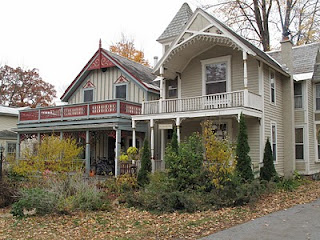
My childhood Thanksgivings began with the two-hour drive from our house in Saratoga to my grandparents' home in the Berkshires.
My grandfather had converted a small cottage with expert craftsmanship. Every aspect of the house had been analyzed or changed to reflect his passion to mold a home into the rural landscape.
Opening the door into the tiny kitchen, my sister and I first sensed the aroma of the gas stove, next the smell of the turkey roasting. 

Tradition dictated that my grandfather carve the turkey at the table, giving my grandmother the first portions and then going in order of women, oldest to youngest, and then men, oldest to youngest. With only seven people in attendance, the process didn't keep us from eating for long.
I loved Thanksgiving, but how could I not--it was wrapped up in my birthday!

The party was for me and I had the chocolate cake to prove it, until my grandmother (according to my mother) tactfully told my mother that birthday cake after a complete Thanksgiving dinner was just too much.
After that, dessert was pumpkin pie, made in an 8x8 inch square pan. No one remembers why Grandma made pumpkin pie in a square. She didn't make apple pie in a square, but that is how my childhood Thanksgivings went--one pie, plenty for only seven people, baked in a square.
But what to do about the birthday? Candles could go in anything. Certainly they worked well in pumpkin pie, but when they turned up in the stuffed celery during the cocktail hour, or in little hot dogs with American cheese on a cracker, a new tradition was born. 

To make my Thanksgiving birthday even better, my grandmother's birthday was two days before mine. Sometimes one of our birthdays fell on the actual day of Thanksgiving. Definitely an excuse for more celebration. And candles had found a permanent home in the appetizers. (note them flaming on the tray table in the photo)
My grandmother, affectionately called "pleasingly plump" by my grandfather, was warm, snuggly, and covered in large Irish freckles. What I wouldn't give to see all these people with adult eyes, when the "old" relatives were only in their sixties. Just five minutes to view this scene in a home I have cherished in my memory for decades.

Time passed and traditions changed. Only twice have Bill and I had Thanksgiving in our own home. The first time was in 1984 with Meredith just days from being born. My mother said, "we will bring Thanksgiving to you." And they all came, the same seven people from my childhood, along with Bill, Thomas at two years old, and my nephew, Daniel. My mother brought the turkey and put it in the oven at my house. There would soon be a new birthday to combine with my own.
We were snowed in the second time we had Thanksgiving at home. We had planned to be with Bill's family, but the forecast had been dire all week. My father called, "Don't worry if you can't get to the Catskills. You can be with us so you won't be alone." Fortunately, I had bought a chicken to roast. No one went anywhere. Snow came down in big flakes across the entire Northeast all day.
No one went anywhere. Snow came down in big flakes across the entire Northeast all day.
 No one went anywhere. Snow came down in big flakes across the entire Northeast all day.
No one went anywhere. Snow came down in big flakes across the entire Northeast all day.In time, the holiday had a constant place in my parents' Saratoga home. To a new set of grandchildren, "going to Grandma's" now meant going there. My mother had name cards on the table cut from colored paper in the shape of oak leaves and plastic pumpkins filled with candy corn next to each plate. 

Eventually, my sister's and my combined families numbered six children, and the house was filled with activity as the turkey roasted, glasses were filled, and good wishes toasted. Birthday candles began to appear again, sometimes in the appetizers, sometimes in the pie (now made in a circle).
Last year, in their new home, my parents had the holiday as they have for years. A couple of the grandchildren could no longer come, but new significant others joined the group. My mother now has a gas stove, and when I walk in, I smell the aromas of my childhood Thanksgivings---the stove and the turkey.


My mother always teases that she is going to "drink heavily" and may ruin the meal (a whiskey sour, her drink of choice), and in the next breath insists that Bill will have to carve the turkey despite having had a manhattan.


And the candles? My sister stood them in the appetizers.
My mother claims that this Thanksgiving will be the last one she and my father will host. She also told me that since my birthday is three days after the holiday, we would not have candles. What could I say except, "At my advanced age (turning 54), I'll try to handle it!"
I am thankful that both of my parents, at ages 85 and 86, are in their home and able to celebrate another year with all of us. I am thankful that my children are well and happy. Thomas and Marlie will be with her family for the day, and Meredith with us. My sister and her growing family will bring a new baby.
And when the day is over and we are all full of turkey and stuffing and pie, we will go home. Thomas and Marlie will arrive for the weekend, and Meredith and I will have a shared birthday celebration on Sunday with chocolate cake.



















